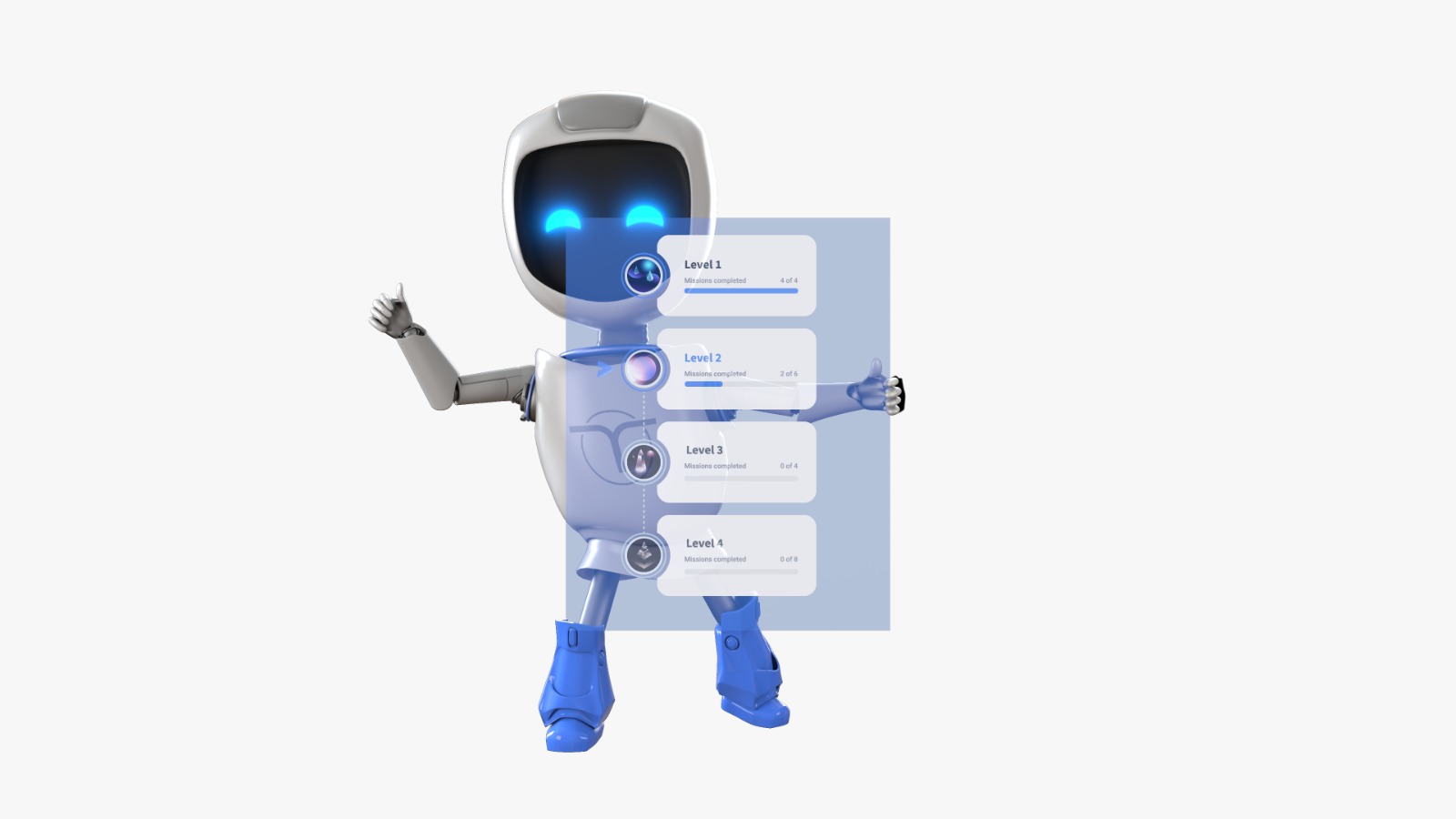Most companies wait too long to fix productivity issues. They throw tools, meetings, and pressure at the problem, when what they really need is better-trained people. This is why productivity training for employees is one of the smartest investments any company can make. As we covered in our employee productivity guide, productivity improves through a series of interconnected factors, including consistent learning.
And research from the HR Director backs this up: companies who prioritize development see better productivity, stronger employee engagement, and improved results across departments. Training helps people work smarter, adapt faster, and stay focused on what matters.
In this article, we’ll explore how to design a training program that improves productivity, without wasting time or resources.
What is Productivity Training?
Productivity training is targeted learning that helps employees work more efficiently, make smarter decisions, and manage their resources better. It’s a strategic development that builds the habits and skills that drive real performance.
Whether it’s time management, communication skills, technical tools, or task prioritization, productivity training for employees closes the gap between potential and output.
The Impact of Productivity Training for Employees on Performance and Business Results
Productivity training delivers far more than quicker task completion. Companies that prioritize learning and development build teams that are engaged, motivated, and consistently high-performing.
Research from Deloitte reveals that organizations with a strong learning culture outperform their peers across multiple critical business areas:
- 52% more productive
- 17% more profitable
- 56% more likely to be first to market with new products and services
- 30–50% higher employee engagement and retention rates
The trend continues with more data. In 2022, The HR Digest found that companies investing in employee development experienced:
- A 24% increase in productivity
- A 58% improvement in employee retention
These improvements translate into significant competitive advantages. Well-trained employees make better decisions and respond faster to change. This, in turn, reduces costly errors (as employees perform better) and turnover (as people value growth and choose to stay).
In essence, productivity training is a powerful strategy that fuels business success by empowering employees to perform at their best, now and into the future.
Key Elements of an Effective Productivity Training Program
An effective productivity training for employees program must focus on practical skills and knowledge that impact how employees perform their tasks. Training that addresses real-world challenges equips your team to work smarter and save valuable time.
Below are the essential elements to include in the training program, along with actionable ways to implement each.
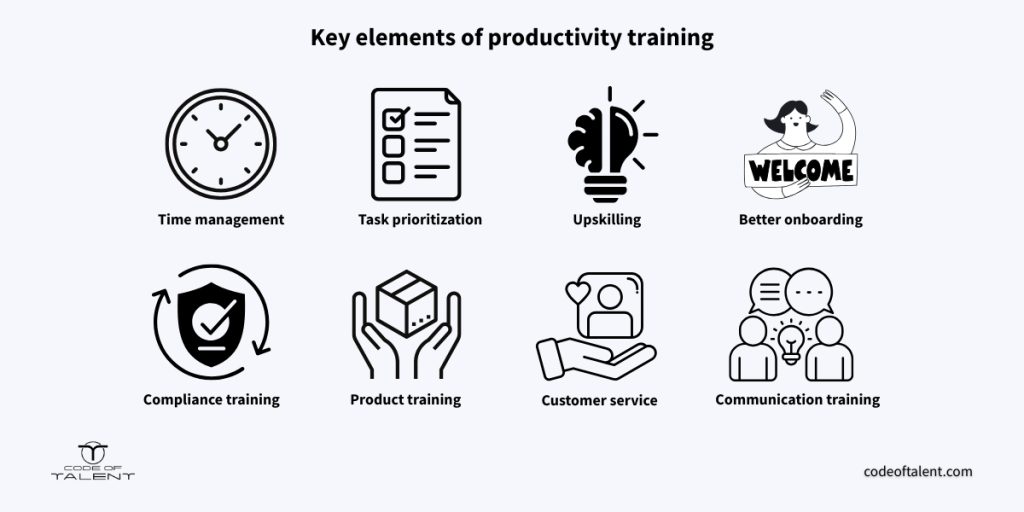
1. Time Management
Time management should be the number one priority in delivering productivity training for employees. Without good time management skills, employees risk working long hours without producing meaningful results. This leads to burnout and missed deadlines and ultimately, to frustrated employees.
How to include it in the program:
- Introduce techniques such as time blocking, the Pomodoro Technique, or delegation matrices.
- Help employees identify common distractions and develop personal strategies to minimize them.
- Encourage daily or weekly planning habits to set clear priorities.
- Provide tools like digital calendars or task managers and train employees to use them effectively.
- Use interactive game-based missions such as prioritizing a set of tasks according to importance.
2. Task Prioritization
Task prioritization, as part of time management, is an essential step in building an effective productivity training for employees. When employees prioritize their workload effectively, they focus on the tasks that matter. This doesn’t mean that they ignore low-impact tasks, but that they organize them around clear priorities like urgency, importance, and deadlines.
How to include it in the program:
- Teach frameworks like the Eisenhower Matrix to differentiate urgent vs. important tasks.
- Use real project examples to practice breaking down and ranking daily tasks.
- Encourage managers to reinforce prioritization in one-on-one meetings and team briefings.
- Integrate prioritization exercises into the training program to build consistent habits.
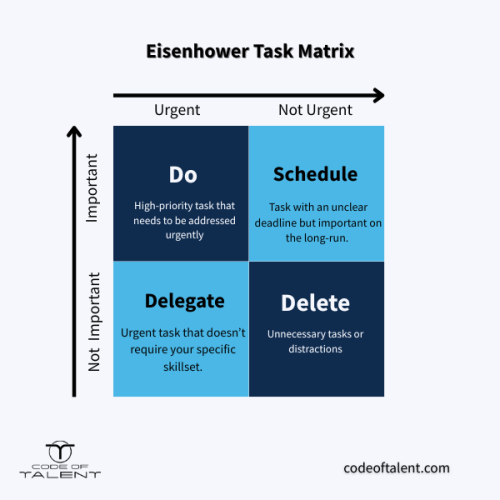
3. Upskilling
Improving employees’ skills is critical for avoiding productivity lags. Upskilling doesn’t refer only to soft skills, but to technical ones as well. It’s important to address both spectrums for two different reasons:
- Soft skills to improve team dynamics, interactions with customers, and resistance to disrupting factors such as stress and workload;
- Technical skills to help employees master new tools and techniques.
How to include it in the program:
- Conduct skills gap analyses to identify where employees need additional training.
- Offer training on relevant software, automation tools, or industry-specific skills.
- Use microlearning modules (training in the format of “missions” that last no longer than 7 minutes) to fit into busy schedules and reinforce learning.
- Include milestones to motivate training progress and recognize achievements.
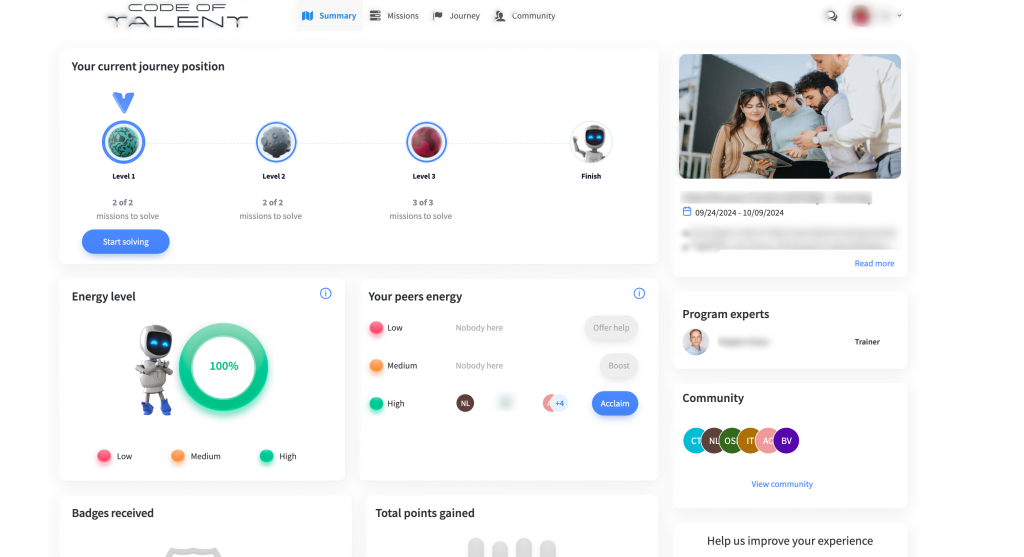
4. Better Onboarding
The shorter the time to productivity for a new hire, the quicker they start adding value, saving your company time and resources. Research shows 49% of employees who experience effective onboarding start contributing meaningfully within the first week, which significantly accelerates team productivity.
How to include it in the program:
- Design onboarding sessions that include workflows and productivity hacks from day one.
- Assign mentors who can guide new hires through common challenges and questions.
- Break onboarding into manageable phases with clear objectives, so progress is trackable.
- Use feedback from recent hires to improve the onboarding process.
5. Compliance Training
If you’re thinking that compliance training is just about avoiding legal trouble, it actually directly influences productivity. Employees work better when they know when to prevent disruptions, and the compliance training also diminishes the fear of making mistakes.
How to include it in the program:
- Integrate real-life study cases that show the importance of compliance training on day-to-day work.
- Use interactive content (such as gamification) to keep learners engaged and help them retain information.
- Schedule regular refresher courses.
- Link compliance topics to operational best practices.
- Use platforms that integrate AI to transform clunky compliance materials into microlearning missions.
Code of Talent, for example, uses AI to generate training missions from your company’s existing materials. Once you upload the relevant documents and answer four key questions, the platform does the heavy lifting. This makes compliance training faster to set up, easier to follow, and far less of a burden—for both training facilitators and employees.
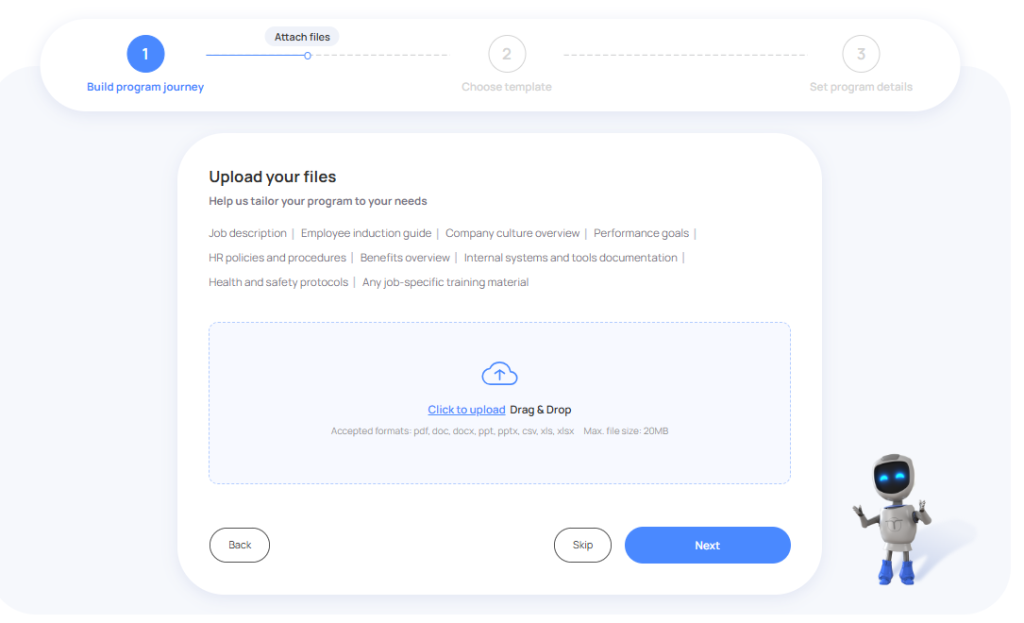
6. Product Training
A deep understanding of the company’s products or services allows employees to work faster, solve problems independently, and support customers more efficiently. Product training should be included in the first days of onboarding and then reinforced at least when updates happen or when employees need a refresher.
How to include it in the program:
- Offer hands-on workshops where employees can practice using products or service platforms.
- Develop quick-reference materials and FAQs employees can access anytime on the job.
- Host cross-team sessions where product knowledge is shared between departments.
- Include product updates and feature changes regularly to keep knowledge fresh.
7. Customer Service Training (If Applicable)
For teams that interact with customers, efficient customer service reduces time spent on repeated issues and improves satisfaction, both key to better productivity. This type of training should focus on: essential customer service skills, as well as operational and technical skills, targeting both the product and the customer.
How to include it in the program:
- Use role-playing exercises to prepare employees for common and challenging customer interactions.
- Train staff on communication skills that clarify and resolve issues quickly, like active listening and empathy.
- Provide guidelines for escalating issues properly.
- Monitor customer service key performance indicators (KPIs) and tailor training to address weak spots.
8. Communication Training
Miscommunication is a hidden productivity killer. It leads to conflicts between colleagues and management, mistakes, delays, and even serious issues such as customer complaints. Strong communication skills keep teams aligned and employees sharp in every interaction.
How to include it in the program:
- Train all forms of communication (verbal, nonverbal, or written).
- Teach employees how to write clear, concise emails and messages that reduce back-and-forth.
- Promote the use of standardized templates and tools to streamline updates and reporting.
- Encourage regular check-ins and structured meetings with clear agendas to avoid wasted time.
- Include training on virtual communication tools, especially for remote or hybrid teams.
- Use real-life simulations or role plays to train handling difficult interactions.
Best Practices for Providing Productivity Training for Employees
The goal of creating a productivity training program is to help employees retain information, apply it quickly, and stay engaged throughout the process. Here are proven methods for that:
Use Microlearning to Avoid Overload
Breaking down content into short, focused sessions allows employees to learn without disrupting their day. This approach improves retention and helps employees apply new skills immediately, whether it’s a five-minute tutorial on prioritization or a quick refresher on using a digital tool.
- Structure training into modules that take under 10 minutes to complete
- Deliver bite-sized lessons through mobile-friendly platforms
- Reinforce with quizzes, real-life scenarios, or short follow-ups
Make Training Engaging with Gamification and Rewards
According to Deloitte, organizations with recognition programs see 14% higher employee engagement, productivity, and performance than those without them. Gamified training motivates participation and encourages employees to complete learning paths. Leaderboards, points, badges, or immediate recognition turn routine training into something people want to return to.
- Recognize progress with visual milestones
- Offer real rewards like extra time off or small bonuses
- Encourage healthy competition with team-based challenges
Invest in a Dedicated Learning and Development Function
To drive results, companies need a dedicated Learning & Development (L&D) team that owns the training roadmap, manages tools, and tracks outcomes. This team turns training initiatives into real progress. Since the pandemic began, 57% of organizations have increased their L&D budgets, recognizing that effective training directly improves output.
- Assign an L&D lead or team to oversee training strategy
- Build a calendar for continuous learning, not just onboarding
- Monitor ROI with training KPIs
Productivity Training Tactics by Role
Not every job requires the same training approach. Tailoring your productivity training for employees to the realities of each role helps maximize real-world impact.
Customer-Facing Employees (Retail, Call Centers, Front Desk)
For roles that deal directly with customers, response time and consistency are crucial.
Support productivity by:
- Training for real-world interactions: Use role-plays and response simulations.
- Giving access to mobile learning: Enable quick refreshers before shifts or during downtime.
- Embedding soft skills: Improve communication and active listening to cut down on escalations.
Hospitality Employees
Improving employee productivity in hospitality comes down to speed, consistency, and customer experience. These teams are often on the go, with little time for traditional, lengthy training programs.
To deliver results:
- Use mobile-first training: Let staff access microlearning lessons on their phones during breaks or between shifts.
- Incorporate simulations and scenarios: Practice customer interactions, complaint handling, or upselling in a low-stakes environment.
- Mix training with live application: Combine microlearning with shadowing, on-the-job missions, or brief daily refreshers.
Non-Customer Facing Employees
Back-office and operational roles benefit from productivity training programs that improve focus, task management, and tool use.
Effective tactics include:
- Time management and prioritization training: Help employees work smarter, reduce multitasking, and hit deadlines.
- Process training: Create clarity around responsibilities and workflows to reduce back-and-forth.
- Tool-specific learning paths: Teach employees how to utilize digital tools that speed up their day-to-day tasks.
Team Leads and Managers
Managers play an important role in shaping how productivity is modeled and sustained.
To empower them:
- Provide leadership training: Focus on goal-setting, feedback, delegation, and productivity coaching. Provide this type of training to new managers in particular.
- Teach data-driven performance tracking: Let them identify productivity gaps early and respond with training or support.
- Create peer learning opportunities: Encourage sharing of strategies among leaders to scale what works.
How to Design the Best Productivity Training Program
A successful productivity training program for employees is built on data, intention, and smart choices, following these 4 steps:
1. Identify What Needs Improvement
Before building anything, analyze performance gaps:
- Use KPIs like task completion rates, project turnaround time, and time spent in meetings vs. outcomes delivered.
- Talk to team leads and employees: where are they getting stuck or wasting time?
- Look at absenteeism, burnout signs, or low output areas that signal underlying issues.
- Search for training KPIs to improve as well: completion rates, feedback quality, or engagement.
2. Set Clear, Actionable Training Goals
You can’t improve what you don’t measure. To make your productivity training for employees truly effective, your goals need to be SMART:
- Specific: Define exactly what the training should achieve.
- Measurable: Attach numbers or data points to track progress.
- Achievable: Set goals that push teams but stay realistic.
- Relevant: Make sure each training goal aligns with your actual challenges.
- Time-bound: Set a clear timeframe to assess impact.
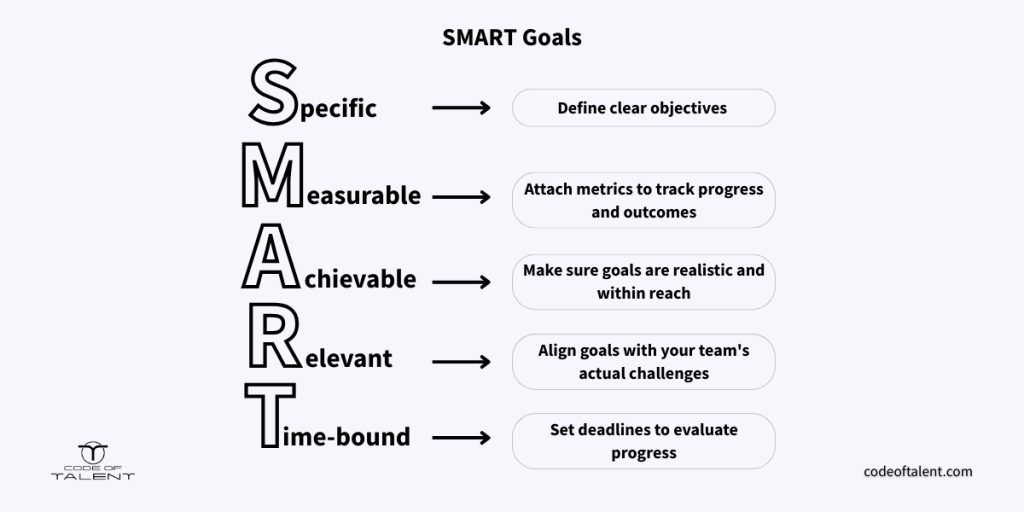
3. Choose the Right Training Platform
The platform matters just as much as the content. A good platform makes your productivity training for employees accessible, trackable, and engaging.
Look for:
- Mobile-first accessibility (especially for industries like hospitality)
- Microlearning formats to avoid overwhelming learners
- Built-in feedback tools and analytics to track progress
Take advantage of free trials to explore what works best for your team. With Code of Talent, you can test-drive productivity training for employees. Use the free trial to build your own training journey from scratch and see how easily it fits your needs, your pace, and your people.
4. Choose the Right Type of Training for the Needs Identified
Start by aligning the training content with the actual challenges. For example if a support team struggles to close tickets on time, focus on time management and task prioritization.
Once the “what” is set, move on to the “how,” as format matters just as much as content.
Choose formats that match your team’s working style and the training objective:
- Interactive quizzes and scenarios for knowledge checks
- Short video lessons for busy schedules
- Simulations and role-plays to recreate real-world challenges
- Open-ended reflection questions to drive critical thinking

5. Measure Effectiveness and Adjust
Productivity training should evolve based on results, but don’t wait until the end of the year to evaluate. Track training outcomes regularly and adjust the program according to these findings. Some training KPIs include:
- Completion Rate: Percentage of employees who complete the training within the set timeframe.
- Knowledge Retention: Scores on quizzes or assessments after training to measure how much employees remember.
- Time to Competency: How long it takes employees to apply new skills effectively on the job.
- Employee Engagement: Participation rates and feedback scores on training sessions.
- Performance Improvement: Changes in productivity metrics linked to training topics (e.g., faster task completion, fewer errors).
- Training Satisfaction: Survey scores on the perceived relevance and quality of the training.
- On-the-Job Application Rate: Percentage of trained employees who demonstrate new skills in their daily work.
- Training ROI: Calculated return on investment by comparing productivity gains to training costs.
- Reduction in Errors/Incidents: For compliance or technical training, track decreases in mistakes or safety incidents.
- Manager Feedback: Qualitative and quantitative feedback from supervisors on employee improvements post-training.
Real-Life Examples of Productivity Improvement with Code of Talent
Real-world results show how Code of Talent drives productivity training for employees by accelerating skill development, optimizing time, and reducing turnover. Here are some standout success stories:
Company | Key Results | Details |
KPMG | 70% of employees improved capacities and skills | Skill acceleration achieved in 3 months instead of 6 months |
Coca-Cola | 80% of employees improved skills Time optimized by 50% | Training outcomes accelerated in 3 months instead of 6 months |
OTP Bank | Employee turnover decreased by 70% Time optimized by 85% | Significant productivity gains and retention improvement |
These cases demonstrate how a focused productivity training program can transform employee capabilities quickly, saving time and improving overall business results.
Productivity training for employees is essential to driving these improvements, and investing in the right tools makes all the difference. Start your journey today with Code of Talent’s free trial and experience how a tailored training program can improve your team’s productivity and impact.
Cover photo: Freepik





